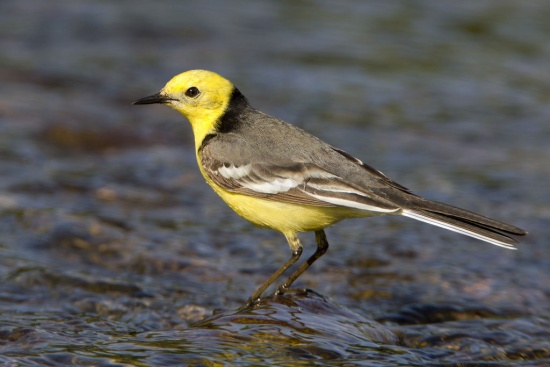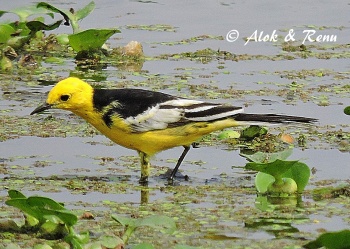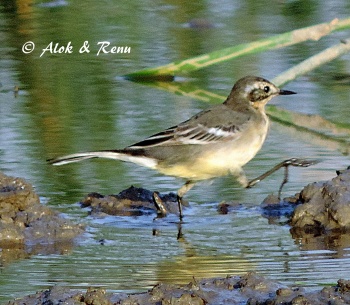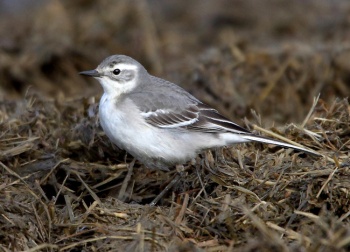- Motacilla citreola
Identification
Length 15.5-17 cm (6-6¾ in), weight 18-25 g.
A wagtail with a medium-length tail, and two very noticeable white bars on wing coverts.
Summer male: Lemon-yellow head, black hind collar and blue or slate-grey upperparts. Bright yellow below.
Female and winter male are much duller, with strong yellow only on face and chest, and light yellowish on belly.
Juvenile and first winter are even duller, with little or no yellow tones at all.
Similar Species
Yellow Wagtail, which lacks the grey back. Juveniles can resemble juvenile White Wagtails, but lack the black face and breast markings and usually have stronger white wingbars.
Distribution
Citrine Wagtail has a breeding distribution from Russia through Siberia, and south to northern Iran, Afghanistan, India, Tibet, China, and Myanmar. In recent decades it has colonised slowly westward, and now breeds in small numbers in Finland, the Baltic States, Belarus, and Poland.
The species is migratory over most of its range, and is a rare but regular guest to western Europe, mainly in early autumn, but also a few spring records; there are also wintering and spring passage records from northwest Africa.
Vagrant to South Africa with one record from the Eastern Cape, and the United States with one record in Mississippi.
Taxonomy
A recent paper by Pavlova et al. (2003)[1] has proposed that Citrine wagtail should be split into two species, an eastern and a western part[2]. The evidence came from DNA analysis and indicated that when an analysis included Yellow Wagtail, the two populations of Citrine wagtail were not each others closest relatives. This split is not at present accepted by many taxonomic authorities but if it were to become accepted, the western species (corresponding to the western portions of the breeding ranges of subspecies M. c. citreola and M. c. werae) would breed west and south of a line from a little east of the west end of Mongolia to the White Sea, while the eastern species (corresponding to the eastern portions of their breeding ranges) would be confined to areas north and east of that line. The authors did not sample from the range of M. c. calcarata.
Subspecies
There are two[2] or three[3] subspecies:
- M. c. citreola: northern parts of the breeding range: eastern Finland (rare), northern Russia to Siberia, Mongolia and Manchuria
- Breeding male with grey rump and mantle and black collar; greater coverts grey with broad white tips
- M. c. werae: mid-latitudes of the breeding range: eastern Poland and the Baltic States (rare), and Belarus, Ukraine, the Kazakh and southern Siberian steppes, to western China (Xinjiang)
- Breeding male as M. c. citreola but slightly paler overall and with less dark collar. Treated as a synonym of M. c. citreola by IOC[2]
- M. c. calcarata: southern parts of the breeding range: eastern Iran to northern Afghanistan, Tibet, southern China and Burma
- Breeding male with wholly black rump and mantle; greater coverts largely white giving a white wing panel
Females and immatures are not currently known to be identifiable to subspecies. All three subspecies winter mixed together in southern Asia, from southern Iran through Pakistan and northen India to northern Thailand and southern China.
Three other subspecies have been described but are not generally accepted, with M. c. quassitrix considered a synonym of M. c. citreola, M. c. sindzianicus a synonym of M. c. werae, and M. c. weigoldi a synonym of M. c. calcarata[4].
Habitat
Wet meadows, tundra, bogs.
Behaviour
Less inclined to bob the head or wag the tail than other wagtails.
Breeding
It is a ground nester and 4-5 speckled eggs are laid.
Diet
The diet includes insects.
Vocalisation
Call often similar to Yellow Wagtail, but can be a bit harsher:
<flashmp3>Motacilla citreola (song).mp3</flashmp3>
Listen in an external program
References
- Pavlova, A., Zink, R. M., Dvoretsky, S. V., Red'kin, Y., & Rohwer, S. (2003). Phylogeographic Patterns in Motacilla flava and Motacilla citreola: Species Limits and Population History. The Auk 120 (3): 744–758
- Gill, F and D Donsker (Eds). 2017. IOC World Bird Names (version 7.1). Available at http://www.worldbirdnames.org/.
- Clements, J. F., T. S. Schulenberg, M. J. Iliff, D. Roberson, T. A. Fredericks, B. L. Sullivan, and C. L. Wood. 2016. The eBird/Clements checklist of birds of the world: v2016, with updates to August 2016. Downloaded from http://www.birds.cornell.edu/clementschecklist/download/
- Del Hoyo, J, A Elliot, and D Christie, eds. 2004. Handbook of the Birds of the World. Volume 9: Cotingas to Pipits and Wagtails. Barcelona: Lynx Edicions. ISBN 978-8487334696
- Wikipedia
- Collins Field Guide 5th Edition
- Collins Bird Guide ISBN 0 00 219728 6
Recommended Citation
- BirdForum Opus contributors. (2024) Citrine Wagtail. In: BirdForum, the forum for wild birds and birding. Retrieved 18 April 2024 from https://www.birdforum.net/opus/Citrine_Wagtail
External Links








